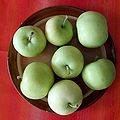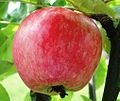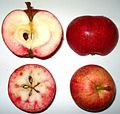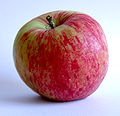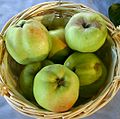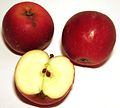Apple ripening class
Apple ripening classes are a classification principle that records apple varieties according to their respective ripeness for picking and consumption. A distinction is made between summer apples, autumn apples and winter apples. In view of the globalized market economy and the associated constant availability and longer shelf life through cold storage in a low-oxygen atmosphere ( CA storage ), in a protective atmosphere or because of fumigation with 1-methylcyclopropene (MCP), this distinction is hardly relevant anymore. In the course of climate change , there are also signs of shifts.
When it is ripe for picking, it means that the fruit is already picked from the tree . A winter apple is not yet ripe for consumption in autumn when it is picked before the first frost, but only becomes this through the subsequent storage. The ripening of summer and autumn apples can also be delayed by picking the fruits shortly before final ripeness (colloquially "green" for immature ) (the seed kernels are still white to light brown) and only ripening during storage (the kernels are then uniformly dark brown). The shelf life is strongly dependent on the thickness of the natural wax layer that the fruit forms; it prevents evaporation of moisture and thus "shrinkage" .
The ripening periods of the fruits are usually given in Roman numerals for the months, for example "IX-III".
Summer apples
Summer apples are apple varieties with early to very early ripeness, some of which ripen as early as July (these especially: early apples ), mostly in August , but at the latest before the main harvest time in mid to late September. Before the global fruit trade began in the second half of the 20th century, summer apples were in demand as the first apples of the new year because of their early ripeness. In terms of taste, summer apples are often characterized by a lot of refreshing acidity with a rather low aroma.
Some summer apples are very sensitive to pressure and can hardly be stored after ripening, or only for a very short time, as the ripening process progresses quickly and the apples become floury or overripe. The malic acid is broken down into lactic acid , which tastes less sour , and the acid gives way to the floury sweetness. They are therefore picked shortly before the final ripeness and they ripen during the manipulation in the trade. Because they perish quickly, they are more likely to be found in local shops and are reserved for self-sufficient cultivation in your own garden.
- Examples of summer apples
Typical summer apples are the ' Klarapfel ', ' Schöner aus Bath ', ' Peach red summer apple ', ' Jamba ', ' Red Astrachan ', ' Astramel ', 'Mantet' Stark's Earliest and ' Piros '. There are also many other varieties, some of which are only distributed regionally.
Autumn apples
Autumn apples are apple varieties that are ripe for picking between September and October and are ready to eat immediately or after only a short storage period. Before there was a permanent supply of fruit from the supermarket, autumn apples (next to storable pears ) were one of the most important sources of fresh fruit in autumn and winter. Another source of supply for fruit in the cold season was only canning and musting.
- Examples of autumn apples
Typical autumn apple varieties are Alkmene , Grahams Jubiläumsapfel , Holsteiner Cox and James Grieve . Other well-known autumn varieties are u. a. Gelber Edelapfel , Fame from Kirchwerder , Maunzen , Gewürzluiken as well as some varieties from the Renette group such as Cox Orangenrenette , Baumanns- and Kanadarenette .
Winter apples
Winter apples refer to apple varieties that have to be stored for two months or longer after the harvest in autumn - usually in October or November - and are usually not ripe until December or later. Winter apples are therefore so-called storage varieties. In some exceptional cases, winter apples can be rented into June. An example of an extremely long shelf life is the Rote Eiserapfel , which can be kept in burrows until the summer of the year after next. Before the permanent supply of apples from New Zealand, Chile and South Africa, the long-lasting winter apples were one of the most important sources for the supply of fruit. A clear and clear separation of winter apple varieties from autumn apple varieties is not possible, as some varieties are ready to eat from October to March.
- Examples of winter apples
Typical winter apple varieties are the red Eiserapfel already mentioned, the Borsdorfer apple , Finkenwerder Herbstprinz , Glockenapfel , Gloster , Ontarioapfel , Rhenish bean apple and Altländer pancake apple , as well as Berlepsch , Rote Sternrenette , Schöner von Boskoop , Topaz and Weißer Winter-Calville (also strawberry because of the taste - or called the apple of paradise). There are also many other varieties, some of which are only distributed regionally (so-called local varieties, for example Roter Pariner and Edler von Leipzig ).
Christmas apple
Christmas apples are colloquially rather small and mostly red winter apples. Before Christmas tree decorations made of glass appeared and became affordable for the general public, they were used to decorate fir branches or Christmas trees. For this, a small size (to allow hanging on thin twigs), a beautiful - mostly red - color and a shiny, polishable bowl were desirable. The red Christmas apples provided the template for today's Christmas tree balls ; allegedly an impoverished glassblower from Lauscha in Thuringia invented glass jewelry in 1847 because he could not afford real apples.
There is a large, essentially regional variety of Christmas apples, most of which are old apple varieties . Examples: Red Star Renette , Red Pariner , Purple Cousinot, and Spartan.
Individual evidence
- ↑ L. March: The Apple Handbook: Interesting facts about the apple. Diplomica Verlag, 2011, ISBN 978-3-836-69888-7 , p. 57 ( limited preview in Google book search).
- ↑ Rosemarie Zehetgruber: Practical handbook of course conservation. Löwenzahn Verlag, 2016, ISBN 978-3-706-62816-7 ( limited preview in Google book search).
- ↑ Séverine Gabioud, Ernst Höhn, Franz Gasser, Daniel Baumgartner, Werner Naunheim, Thomas Eppler: Cold storage plus MCP as a replacement for CA storage? , Switzerland. Z. Obst-Weinbau, No. 15/07, PDF file
- ↑ Apfelbaum In: Meyers Großes Konversations-Lexikon , Volume 1. Leipzig 1905, pp. 612–614.
- ^ Herbert Petzold: Apple varieties Neumann Leipzig 1990, p. 28, "Reifezeitgruppen", ISBN 3-7402-0075-8
- ^ Herbert Petzold: Apple varieties Neumann Leipzig 1990, p. 44, "Picking maturity", ISBN 3-7402-0075-8
- ↑ Robert Steidl: Biological acid degradation . Ulmer, 2002, ISBN 978-3-800-13913-2 .
- ↑ TEUBNER Food. Gräfe Und Unzer, 2011, ISBN 978-3-833-81966-7 , p. 140 ( limited preview in the Google book search).
- ↑ variety description Mantet, PDF, 2 MB
- ↑ L. March: The Apple Handbook: Things worth knowing about apples , Hamburg 2011, p. 19.
- ↑ Apfelbaum In: Meyers Großes Konversations-Lexikon , Volume 1. Leipzig 1905, p. 612.
